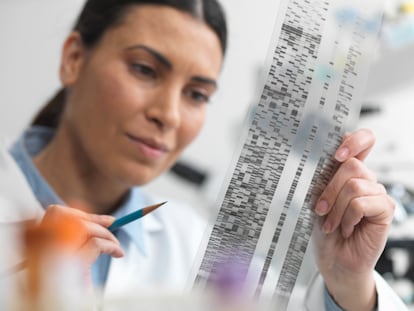The mysterious role of ancient viruses embedded in human DNA
About 8% of the genome is made up of viral relics, silent remnants of ancient pandemics. When resurrected, they can play a role in our health and wellbeing

In the blueprint for life that is the human genome, there are some mysterious, silent particles. They perform no function and have gone unnoticed for thousands and thousands of years. They are species of ancestral viruses, remnants of ancient pandemics, that became embedded in the DNA of germ cells (that give rise to eggs or sperm), and were passed from generation to generation. Until today. About 8% of the human genome is made up of these disturbing viral relics, about which we still have much to learn. The little that has been discovered is that when they are resurrected and activated, they can end up playing a key role in our health and wellbeing: for example, sequences of these very ancient viruses can help develop the placenta or encourage tumors and neurodegenerative diseases.
They are human endogenous retroviruses (HERV), viral relics without the ability to infect new hosts and that remained in the body after infections that our ancestors suffered millions of years ago. In a similar way to HIV today, these very ancient retroviruses inserted themselves into the genetic material of the cells in order to replicate. At some point in evolution, these viruses also infected germ cells and snuck viral genetic material into the genome of our species, perpetuating their presence for thousands and thousands of years. “It has been seen that some are common in other mammals, so they may have come from an ancient pandemic. For it to have an impact on evolution, it had to have been a huge pandemic that affected many mammals, and where the viruses had the ability to access germ cells and expand,” explains María del Mar Tomás, a microbiologist at the University Hospital Complex of A Coruña and spokeswoman for the Spanish Society of Infectious Diseases and Clinical Microbiology (SEIMC).
For a long time, these vestiges of past infections were considered silent passengers in our genome. Defective or turned off by epigenetic changes, they were even considered part of the so-called junk DNA we all have because they did not code for proteins. However, the scientific community has been researching their role within the body a little more deeply and has discovered that they are present in healthy and diseased tissues, and they can have a function in all of them. “With evolution, they have acquired multiple functions. Some of these particles have positive functions, such as modulating immunity or protecting us from other viruses; but others are activated negatively and can cause illness. Previously, they were much more associated with disease, but other researchers have found ancestral viral particles in healthy tissue, meaning that in diseases, something else has to be activated. There may be external factors that cause them to be activated and can influence our health,” reflects Tomás.
Many questions remain to be answered, such as what mechanism drives the particles’ activity or inactivity. But science has already begun to link their expression to signs of health or illness. “It is unclear whether the expression of endogenous retroviruses that accompanies neuroinflammation is beneficial or detrimental. Emerging evidence from studies now supports that overexpression of HERV-K [a type of human endogenous retrovirus] in the human brain is not harmful and may exert neuroprotective effects,” a group of Chinese and Italian researchers state in an article published in the journal Frontiers in Microbiology. These endogenous retroviruses have also been shown to be involved in embryonic growth: syncytin, for example, is a protein that originates from a gene derived from viruses embedded in our organism millions of years ago and has a key function in helping to form the membrane of the placenta.
A study published in the journal Science pointed out that some of these pieces of viral DNA spread throughout the genome participate in the regulation of essential immune functions. They act specifically within the innate immune system, which is the first line of defense against germs. “Selfish genetic elements, like these endogenous retroviruses, can spread throughout the genome. If one of the elements ends up near a gene involved in the immune system, natural selection can act to keep the element there, and then it becomes part of the innate immune response,” geneticist Nels Elde, one of the authors of the study, explained to this newspaper in 2016. Tomás also highlights the role of these viral relics in the body’s defense: “They have the ability to activate interferons [proteins that modulate the immune response].”
A role in the development of tumors
Not all of them, however, are good features. HERV-K has multiple copies in the human genome and one of its subtypes, HML-2, is also associated with certain types of cancer and neurodegenerative diseases when aberrantly expressed in adult tissues. “HML-2 has been implicated in the development of cancer, as its expression has been associated with many types of tumors, such as teratocarcinoma, germ cell tumors, melanoma, ovarian, and prostate cancer,” lists another study from the U.S. National Health Institutes.
Along these lines, recent research has also associated the activity of this type of viral relic with the development of glioblastoma, a brain tumor with an extremely unfavorable prognosis. “We report pathological expression of HML-2 in malignant gliomas in both cerebrospinal fluid and tumor tissue that was associated with a cancer stem cell phenotype and poor outcomes,” the authors explained. Joan Seoane, ICREA research professor and co-director of the Preclinical and Translational Research Program of the Vall d’Hebron Institut d’Oncologia (VHIO), admits that knowledge about the role of these ancient virus fragments is still very limited: “We know very little, but we suspect that it is very important.”
The scientists’ hypothesis is that these integrated retrovirus remains acquire mutations and change with no negative effects, but the organism does not like them and silences them with the epigenome, an entire network of chemical compounds and proteins that stick to the genes and, although they do not modify their sequence, they do cause chemical variations that affect their functions. “So, in normal cells, with the epigenome under control, nothing happens. But in tumors, where nothing is controlled and DNA hypomethylation [a phenomenon that contributes to the origin of cancer cells by creating chromosomal instability] occurs, the most recent viral remains can wake up. Cancer, being aberrant, awakens things that we have silenced for millions of years,” explains Seoane.
These viral relics have also been found to have a role in cellular aging. Research recently published in the journal Cell has observed — in monkey organs and human tissues — that these pieces of ancient viruses (specifically, HML-2) can be reactivated and cause the formation of retrovirus-like particles inside cells responsible for aging and cancer. “It is clear that many of these sequences [of viruses integrated into human DNA] begin to get out of control throughout our lives and are associated with most illnesses: neurodegenerative, cartilage, and muscle diseases, as well as cancer,” Spanish scientist Juan Carlos Izpisua, co-author of the study explained to this newspaper a few months ago. According to the researchers, in experiments with cells in the laboratory, they saw that these genetic fossils could reach other younger cells and cause them to age.
These same authors have also delved into another study on the degeneration of neurons during aging and have reported that, in monkeys and humans, the resurrection of endogenous retroviruses promote an immune response and “ultimately, the degeneration of neurons.” Using in vivo and in vitro models, the study also demonstrated that silencing these viral relics inhibits neuronal senility associated with aging.
As for the role of HML-2 in health and disease, the scientific literature has also reported a relationship between the virus particles and amyotrophic lateral sclerosis (ALS). HERV-K RNA sequences have been detected in motor neurons of patients with ALS, and it has been observed that an “increased expression of the HERV-K envelope protein in upper and lower motor neurons was neurotoxic and capable of causing cellular degeneration,” notes an Italian study. In line with neurological diseases, the activation of several HERV families has also been associated with a greater risk of multiple sclerosis and a relationship has also been found between the activity of certain viral relics and the development of schizophrenia.
Pending unknowns
The field of study on HERVs is very broad and there are still many doubts to be resolved about their mechanisms for activation, how they behave, and above all, how to tackle them if, as dozens of investigations suggest, they play an essential role in the development of some diseases. Regarding the influence of HERVs on glioblastoma, Seoane states: “We still need to know what mechanism gives a selective advantage to the tumor; how it helps the cancer grow.”
Globally, regarding the mechanisms that cause these viral vestiges to revive, Tomás also insists: “We have to see what mechanisms there are that cause some humans to have them and others not to. Maybe there are certain types of specific transposons [involved].” Transposons are DNA sequences capable of replicating and, like a kind of jumping gene, they can insert themselves into other parts of the genome. Endogenous retroviruses are just one type, but there are more. The microbiologist advocates finding therapeutic targets in this field to block and eliminate them: “You cannot block all retroviruses because some may have positive functions, but you could treat these transposons, even with CRISPR [a kind of genetic scissors to edit the genome] or with antibodies.”
Sign up for our weekly newsletter to get more English-language news coverage from EL PAÍS USA Edition
Tu suscripción se está usando en otro dispositivo
¿Quieres añadir otro usuario a tu suscripción?
Si continúas leyendo en este dispositivo, no se podrá leer en el otro.
FlechaTu suscripción se está usando en otro dispositivo y solo puedes acceder a EL PAÍS desde un dispositivo a la vez.
Si quieres compartir tu cuenta, cambia tu suscripción a la modalidad Premium, así podrás añadir otro usuario. Cada uno accederá con su propia cuenta de email, lo que os permitirá personalizar vuestra experiencia en EL PAÍS.
¿Tienes una suscripción de empresa? Accede aquí para contratar más cuentas.
En el caso de no saber quién está usando tu cuenta, te recomendamos cambiar tu contraseña aquí.
Si decides continuar compartiendo tu cuenta, este mensaje se mostrará en tu dispositivo y en el de la otra persona que está usando tu cuenta de forma indefinida, afectando a tu experiencia de lectura. Puedes consultar aquí los términos y condiciones de la suscripción digital.
More information
Archived In
Últimas noticias
The metaverse, four years later: Is it finished or just at a standstill?
$3,000 and a plane ticket: The United States increases incentives for migrants to self-deport before the end of the year
Charles Dubouloz, mountaineering star, retires at 36 with a farewell tour inspired by Walter Bonatti
From the White House to diplomatic gifts: Lego wins over adult fans, brick by brick
Most viewed
- Families demand repatriation of bodies of Colombians who died in Ukraine: ‘This war is a slaughterhouse for foreigners’
- The low-cost creative revolution: How technology is making art accessible to everyone
- Liset Menéndez de la Prida, neuroscientist: ‘It’s not normal to constantly seek pleasure; it’s important to be bored, to be calm’
- Christian Louboutin: ‘Young people don’t want to be like their parents. And if their parents wear sneakers, they’re going to look for something else’
- Christmas loses its festive spirit: ICE fears cast shadow over religious celebrations











































